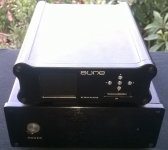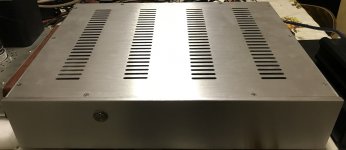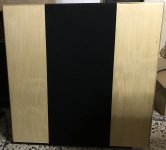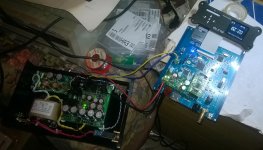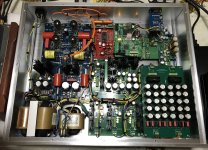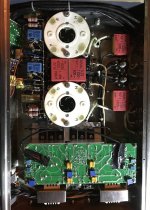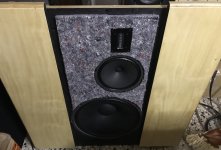Some time ago a friend did ask me for building a complete audio system.
All the devices should be self made, the budget was obviously limited, but large enough to build a very good system.
The system is ready and sounds impressive, one of the best audio system I ever heard.
I called the system "quasi-eastern" because most of the components come from China and Russia: the source and the amplifier from China (although they have been strong tweaked), driver tubes from Russia, 845 tube from China, all the PCBs from China, fullrange and tweeter drivers from China, and so on.
For those who was interested I'm pleased to share all the project: schematics, BOM, drawings, detailed instructions and so on.
Stay tuned!
All the devices should be self made, the budget was obviously limited, but large enough to build a very good system.
The system is ready and sounds impressive, one of the best audio system I ever heard.
I called the system "quasi-eastern" because most of the components come from China and Russia: the source and the amplifier from China (although they have been strong tweaked), driver tubes from Russia, 845 tube from China, all the PCBs from China, fullrange and tweeter drivers from China, and so on.
For those who was interested I'm pleased to share all the project: schematics, BOM, drawings, detailed instructions and so on.
Stay tuned!
Attachments
Architecture of the system
The source is a SD card player based on a chinese commercial device, the Aune X5. It was heavily tweaked, the power supply was totally replaced and the original 22.5792MHz oscillator was removed and replaced with a better one. Finally it consists of two chassis screwed together, one was added for the power supply and the original holds the player. It plays redbook only, but as we will see ahead the source could be replaced with any other to play all material, the only limit is the TDA1541A.
The DAC is based on the TDA1541A chip and while it can only play 16 bit I think it's the better DAC chip ever made. There are a lot of boards in the DAC as you can see in the attached picture. It accepts I2S input only and the format is 16 bit 44.1 kHz, but as I said above the input module could be replaced to accept S/PDIF or USB. The only restriction is that the input module have to output I2S format. After the input module there are some Ian's stuff: a FIFO buffer followed by a single clock board (you can replace it with a dual clock board, simply you need two master clock oscillators rather than one), the I2S to PCM converter board to play the TDA1541A in simultaneous mode (offset binary). Ians' boards are fed by a OCXO at 11.2896 MHz (TWTMC boards). Then there is the Red Baron TDA1541A board followed by a passive I to V converter based on a Rhopoint resistor. Finally there is a Broskie's All in One AIKIDO 9 pin tube as the gain stage and buffer. The remaining stuff are all power supply boards.
The amplifier is a DHT SE based on a chinese commercial device, the Music Angel XD845. Also this device was heavily tweaked, practically I saved the power supply and the irons, the other stuff was thrown out, including the entire driver stage and all the tubes. The tweaking is based on a Barbara Gerhold's schematic, with a little more gain and a little less local NFB in the driver stage, to get it compliant with the relatively low output level of the TDA1541A DAC.
The speaker system is a variant of the well known OBL11 from Troels Gravesen. It's a three way open baffle where I replaced the mid driver with a Alnico full range and the tweeter with a ribbon driver. The sensitivity of the system is around 93.5 dB.
The total cost of the system, including all the parts and the speakers wood baffle, is around Eur 6000 .... and a lot of work!
The source is a SD card player based on a chinese commercial device, the Aune X5. It was heavily tweaked, the power supply was totally replaced and the original 22.5792MHz oscillator was removed and replaced with a better one. Finally it consists of two chassis screwed together, one was added for the power supply and the original holds the player. It plays redbook only, but as we will see ahead the source could be replaced with any other to play all material, the only limit is the TDA1541A.
The DAC is based on the TDA1541A chip and while it can only play 16 bit I think it's the better DAC chip ever made. There are a lot of boards in the DAC as you can see in the attached picture. It accepts I2S input only and the format is 16 bit 44.1 kHz, but as I said above the input module could be replaced to accept S/PDIF or USB. The only restriction is that the input module have to output I2S format. After the input module there are some Ian's stuff: a FIFO buffer followed by a single clock board (you can replace it with a dual clock board, simply you need two master clock oscillators rather than one), the I2S to PCM converter board to play the TDA1541A in simultaneous mode (offset binary). Ians' boards are fed by a OCXO at 11.2896 MHz (TWTMC boards). Then there is the Red Baron TDA1541A board followed by a passive I to V converter based on a Rhopoint resistor. Finally there is a Broskie's All in One AIKIDO 9 pin tube as the gain stage and buffer. The remaining stuff are all power supply boards.
The amplifier is a DHT SE based on a chinese commercial device, the Music Angel XD845. Also this device was heavily tweaked, practically I saved the power supply and the irons, the other stuff was thrown out, including the entire driver stage and all the tubes. The tweaking is based on a Barbara Gerhold's schematic, with a little more gain and a little less local NFB in the driver stage, to get it compliant with the relatively low output level of the TDA1541A DAC.
The speaker system is a variant of the well known OBL11 from Troels Gravesen. It's a three way open baffle where I replaced the mid driver with a Alnico full range and the tweeter with a ribbon driver. The sensitivity of the system is around 93.5 dB.
The total cost of the system, including all the parts and the speakers wood baffle, is around Eur 6000 .... and a lot of work!
Attachments
- Status
- Not open for further replies.
